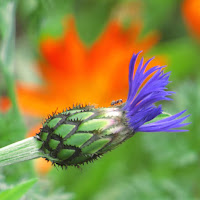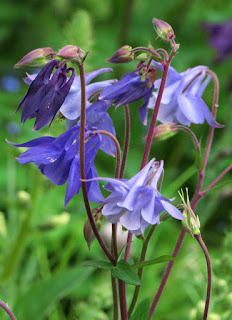"And the May month flaps its glad green leaves like wings,
Delicate-filmed as new-spun silk..."
- Thomas Hardy
 |
| View from our back garden |
Green hillsides are swagged with hawthorn bushes, their pungent white blossoms known as 'may' because they invariably arrive with the month. But you know it's not quite summer as the farmer hasn't yet put his sheep out on the ridge.
Our garden, too, has its share of white flowers at present, none more extravagant than Virburnum opulus which has exceeded itself in producing a huge number of creamy-green spheres.
 |
| Viburnum opulus aka the 'Snowball Tree' |
Sure enough there are thunder-storms forecast this week, but after a long spell of drying winds most of our plants will be glad of some root-refreshing moisture. Real rain always seems to work better than water from cans!
 |
| Orlaya grandiflora available from Chiltern Seeds |
Umbellifers
Lacy flowers of orlaya are more like snowflakes and mimic the soft waves of cow parsley now adorning our back lane.
It's a useful filler plant which seeds itself under our medlar tree and mixes well with other spring flowers such as geum and foxglove, giving the relaxed feel of a meadow.
Seedlings become apparent in early autumn when they can be thinned out and easily moved to other areas if required.
This year we're also growing some Ammi visnaga, a more imposing umbellifer, now coming into bloom and looking as though it will take up considerably more space!
 |
| Cistus ladanifer, standing up to the rain |
White flowers are certainly one way of breaking up the sea of green that engulfs our garden at this time of year. In addition, it's useful to interpose plants with darker foliage, such as Sambucus nigra Purpurea - whose coppery foliage stands out in the border below, to the right of the little box hedge.
 |
| Back border edged with boules of lavender |
Once we've had this promised rainfall, we'll probably yank out annuals like myosotis and put down some garden compost, before re-filling the gaps with Cosmos sulphureus grown from seed.
Another very successful plant from the Chiltern Seeds collection is this maroon-leaved Penstemon digitalis called 'Husker Red', which does a great job of breaking up that aforementioned sea of green!
It's a sturdy fellow, seemingly immune to snails, and produces panicles of white flowers in June. I like the fact that its foliage looks so glossy after watering.
Next to it is one of the Gladiolus Byzantinus that we dotted around the garden last year, again to provide some accent colour and draw the eye from one area to another.
A few of Chiltern's sweet williams which I grew from seed last year have made it through the wet winter and are now throwing up their dark stems amongst the forget-me-nots.
This is Dianthus barbatus 'Sooty' - aptly named, I think, for its cheeky black heads! Sadly some of my little plants came to grief as they over-wintered in our borders, but the survivors are doing well and I can't wait for their eventual flowering.
Generally, all types of dianthus seem to thrive in our garden and I'm gradually working my way through the multitude of varieties in Chiltern's catalogue!
It's a sturdy fellow, seemingly immune to snails, and produces panicles of white flowers in June. I like the fact that its foliage looks so glossy after watering.
Next to it is one of the Gladiolus Byzantinus that we dotted around the garden last year, again to provide some accent colour and draw the eye from one area to another.
 |
| Dianthus barbatus 'Sooty' |
This is Dianthus barbatus 'Sooty' - aptly named, I think, for its cheeky black heads! Sadly some of my little plants came to grief as they over-wintered in our borders, but the survivors are doing well and I can't wait for their eventual flowering.
Generally, all types of dianthus seem to thrive in our garden and I'm gradually working my way through the multitude of varieties in Chiltern's catalogue!
 |
| Geranium 'Orkney Cherry' -an early-flowering variety with finely-cut dark foliage |
For the edge of the border there's a smallish variety called 'Orkney Cherry' which has bronze-green leaves and vibrant pink flowers.
Another cranesbill we bought at a fair, which hasn't produced many flowers to date, is Geranium maculatum 'Espresso', supposed to be suitable for shadier, woodland areas.
I've now divided this into three pieces, to see if it will perform better in other parts of the garden. This year I'm hoping to see lots of white flowers, which would look fabulous against the coffee-brown leaves.
 |
| Centaurea montana |
Nowadays we also search for plants with unusual shapes as they're interesting to photograph... often more so when they're in bud than in full flower.
Centaurea montana, however, delivers on both counts and I love the oval capitulum reminiscent of overlapping insect scales.
 |
| Centaurea montana - perennial cornflower growing on cliffs and mountains, as well as gardens! |
 |
| Aquilegia hybrid |
One of the first flowers to bring in some colour after our bulbs have died down is that good old staple - aquilegia.
I did grow a named variety with deep blue flowers a few years back, but I think this has now hybridised with something else in the garden and produced a rather handsome cousin sporting three shades of blue.
Due perhaps to the wet winter/spring, our aquilegias are taller and more stately this year. Well worth dead-heading to prolong the flowering period.
 |
| Borago officinalis |
This one happened to seed itself by the compost heap in our woodland section, where it was allowed to reach maturity undisturbed and is now covered in blooms. Backlit by early sunshine, it makes for an irresistible photo.
 |
| Anchusa azurea 'Dropmore' - with matching swallowtail butterfly |
If not the biggest flowers, those of Anchusa azurea are some of the most intense in colour, and obviously attractive to this early swallowtail who kept coming back for more!
These plants, which also came from Chiltern Seeds, were widely featured at the Chelsea Flower Show two years ago and soon became a must-have for cottage-style gardens. Ours are now 1.5m tall in full sun and provide plenty of nectar for butterflies.
 |
| A dry border edged with pinks, catmint and Iberis sempervirens |

No comments:
Post a Comment